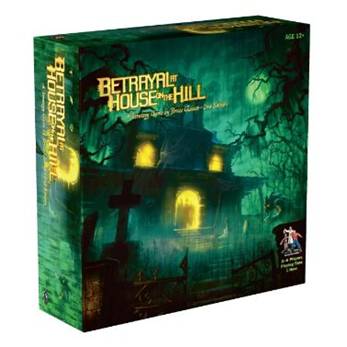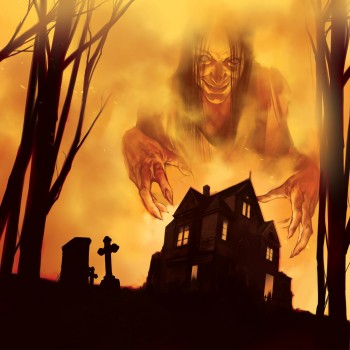Tabletop Terror: Betrayal at the House on the Hill
 I was the only gamer geek in my family growing up. We played Monopoly, Clue, Risk, and so on, the staple games of the twentieth-century American experience, brought to you by Milton-Bradley, but my mother wasn’t a fan. She and my grandmother both tended more toward word games like Scrabble and card games, particularly Rummy variants. I became an avid Solitaire player early on. And we had an Atari, of course, then a Nintendo. So I was a gamer from an early age, but not a board gamer.
I was the only gamer geek in my family growing up. We played Monopoly, Clue, Risk, and so on, the staple games of the twentieth-century American experience, brought to you by Milton-Bradley, but my mother wasn’t a fan. She and my grandmother both tended more toward word games like Scrabble and card games, particularly Rummy variants. I became an avid Solitaire player early on. And we had an Atari, of course, then a Nintendo. So I was a gamer from an early age, but not a board gamer.
From high school and through college, I pretty much abandoned board games in favor of roleplaying games. Advanced Dungeons & Dragons (2nd edition) at first, but eventually I became engrossed in the World of Darkness system from White Wolf Games (now published by Onyx Path Publishing).
Board games had completely fallen off my radar by the time I got out of college and began actively adulting. Board games, after all, were for kids, right? In the age of roleplaying games and video games, including an array of online roleplaying games, surely there was no way a board game could be nearly as engaging, nearly worth the time commitment to play it.
It was Betrayal at House on the Hill (Amazon) that dispelled that illusion, showing me what board gaming had become while I hadn’t been paying attention.
Betrayal at House on the Hill
Among other things, Betrayal at House on the Hill was probably the first cooperative game I ever played. Playtime is about an hour or so (with some wide upper-end variability, I’d say, depending on the group’s focus), for 3-6 players, with a recommended ages guideline of 10+. It was originally published in 2004 by Avalon Hill, the board gaming imprint of Wizards of the Coast, and has a 2010 reprint.
As the name (and cover art) suggests, players are a group of people moving through a haunted house, uncovering new rooms and experiencing strange encounters with the spooky environment. The characters are represented by painted plastic miniatures, and loosely represent a range of archetypes from horror movies: the jock, the priest, the academic, the psychic, the pretty co-ed, the curious kid, etc. Each possible character begins with different statistics (Speed, Might, Sanity, and Knowledge), which can be raised/lowered through various experiences in the game.
For the first half of the game, the players move through the house, uncovering new rooms. These rooms are represented by tiles, so the house’s layout is completely different each time you play the game. You genuinely have no idea what you’re going to run into when you move into a new room. Some rooms trigger effects based on the room, while others have you draw Item, Event, or Omen cards. (Some do both.) The goal of the game is generally to raise your statistics and gain sufficient equipment … before one of the other characters betrays you.
This is the major twist to the game, making it absolutely unlike any other game I had encountered at that point. Each time you draw an Omen card, you end the turn by rolling 6 dice (special ones, with 0 to 2 pips on the various sides). As soon as this role is less than the total number of Omen cards you have, “The Haunt” is triggered, and one of the other players becomes the enemy of everyone else who is playing.
In other words, the game transforms from a fully cooperative game to a partially-cooperative game, where everyone attempts to stop the possessed character/hellbeasts/monsters/etc. that are coming to kill you all (or worse). Based upon which room and Omen card that triggered The Haunt roll, you end up with one of 50 different possible Haunts, each of which introduces a new type of threat and victory conditions, as well as an indication of who will be the betrayer. (It isn’t necessarily the one who rolled The Haunt.) The group of non-evil players look up the appropriate page in the “Secrets of Survival” booklet to figure out what they know and what they are trying to accomplish, while the betrayer goes off to look up their information in the “Traitor’s Tome” booklet.
In addition to being my first cooperative game, this is also the first game that taught me the importance of buying baggies to sort all of the elements, because almost all of the 50 different scenarios involve tokens that are useful in that scenario, often representing monstrous minions that the betrayer now has control over, though sometimes representing portals or other environmental elements.
In several cases, either the heroes or the betrayer may be ignorant of the precise victory conditions that the others are working toward. For example, the betrayer may know that she has to kill the heroes before they can perform an exorcism, but she may not be given any of the details of what they need to perform the exorcism. Are they looking for a specific Item or trying to get into a specific room? The heroes may be trying to kill all of the rats while the betrayer is trying to complete a “wicked rat-thing ritual,” but the heroes may not know how long they have before the ritual is completed.
 What Betrayal at House on the Hill taught me was that the storytelling excitement of roleplaying can be captured within a box, with the added benefit of a lot less planning on the part of a gamemaster. Just get the box down and get to exploring, and you pretty much instantly feel like you are working your way through a classic horror movie, ready to be betrayed at any moment by those who are closest to you … or, perhaps, to be betrayed even by your own inner demons.
What Betrayal at House on the Hill taught me was that the storytelling excitement of roleplaying can be captured within a box, with the added benefit of a lot less planning on the part of a gamemaster. Just get the box down and get to exploring, and you pretty much instantly feel like you are working your way through a classic horror movie, ready to be betrayed at any moment by those who are closest to you … or, perhaps, to be betrayed even by your own inner demons.
Widow’s Walk
Okay, given this audience, there’s a good chance that many readers will be thinking at this point, “Well, yeah, I’ve known about this game for a decade.” Don’t worry, friends, because there’s excitement even for those who are old hands at the game …
This Friday, October 14, 2016, Wizards of the Coast is releasing the first expansion for the game, Betrayal at House on the Hill: Widow’s Walk (WotC, Amazon). This will include 50 new Haunt scenarios, along with all of the related tokens, and new tiles which include the opportunity to explore a Roof level of the house.
For those who have been dedicated players over the last decade or so, and have worked their through several of the scenarios, this is definitely going to add enough new dynamics to the game to make it even more engaging. For those of us who are still working our way through the first 50 Haunts … well, it just provides an added bit of motivation.
Other Articles of Interest:
- Tabletop Terror: Pathfinder Edition
- I Am Not a Serial Killer film
- GenCon 2016: The Pathfinder Post (featuring Starfinder)
- Dungeons, Dragons, and Vampires: Curse of Strahd
- Pathfinder Goes to the Stars
- Alien Horror Fun with Level 7 [Escape]
- A Touch of Evil: Colonial Gothic Horror Board Gaming At Its Finest
You might want to try out Pandemic Legacy – provided you have a group of friends that is willing to either meet regulary or binge-play in 2 or 3 evenings. Its a full cooperative game about battling diseases…. with a story arc spanning several _games_ (Rules change during and between games, decisions affect the board and cards permanently.
I’ve played Pandemic, but not yet played Pandemic Legacy. It definitely seems like a cool concept, though.